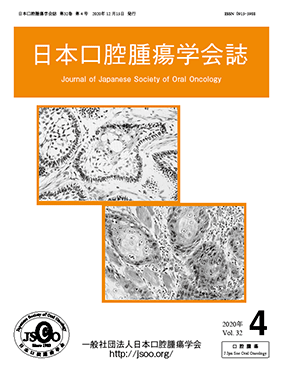Volume 32, Issue 4
Displaying 1-18 of 18 articles from this issue
- |<
- <
- 1
- >
- >|
The 38th Annual Meeting of Japanese Society of Oral Oncology
Symposium 1: Current and future prospects of precision medicine
-
2020Volume 32Issue 4 Pages 129
Published: 2020
Released on J-STAGE: December 22, 2020
Download PDF (136K) -
2020Volume 32Issue 4 Pages 130-133
Published: 2020
Released on J-STAGE: December 22, 2020
Download PDF (229K) -
2020Volume 32Issue 4 Pages 134-143
Published: 2020
Released on J-STAGE: December 22, 2020
Download PDF (809K) -
2020Volume 32Issue 4 Pages 144-152
Published: 2020
Released on J-STAGE: December 22, 2020
Download PDF (755K) -
2020Volume 32Issue 4 Pages 153-158
Published: 2020
Released on J-STAGE: December 22, 2020
Download PDF (509K)
Symposium 2: Utilization of AI for the future of oral cancer medicine ~fusion of medicine, dentistry and industry
-
2020Volume 32Issue 4 Pages 159-170
Published: 2020
Released on J-STAGE: December 22, 2020
Download PDF (2151K) -
2020Volume 32Issue 4 Pages 171-178
Published: 2020
Released on J-STAGE: December 22, 2020
Download PDF (736K)
Symposium 3: Treatment indications for elderly oral cancer patients: What indicators follow age and PS?
-
2020Volume 32Issue 4 Pages 179
Published: 2020
Released on J-STAGE: December 22, 2020
Download PDF (116K) -
2020Volume 32Issue 4 Pages 180-185
Published: 2020
Released on J-STAGE: December 22, 2020
Download PDF (842K) -
2020Volume 32Issue 4 Pages 186-192
Published: 2020
Released on J-STAGE: December 22, 2020
Download PDF (329K)
Symposium 4: Pathology of oral superficial cancer
-
2020Volume 32Issue 4 Pages 193-194
Published: 2020
Released on J-STAGE: December 22, 2020
Download PDF (227K) -
2020Volume 32Issue 4 Pages 195-206
Published: 2020
Released on J-STAGE: December 22, 2020
Download PDF (2052K) -
2020Volume 32Issue 4 Pages 207-217
Published: 2020
Released on J-STAGE: December 22, 2020
Download PDF (1409K) -
2020Volume 32Issue 4 Pages 218-228
Published: 2020
Released on J-STAGE: December 22, 2020
Download PDF (2272K)
Case Report
-
2020Volume 32Issue 4 Pages 229-236
Published: 2020
Released on J-STAGE: December 22, 2020
Download PDF (968K) -
2020Volume 32Issue 4 Pages 237-241
Published: 2020
Released on J-STAGE: December 22, 2020
Download PDF (555K) -
2020Volume 32Issue 4 Pages 243-250
Published: 2020
Released on J-STAGE: December 22, 2020
Download PDF (1047K) -
2020Volume 32Issue 4 Pages 251-257
Published: 2020
Released on J-STAGE: December 22, 2020
Download PDF (653K)
- |<
- <
- 1
- >
- >|
